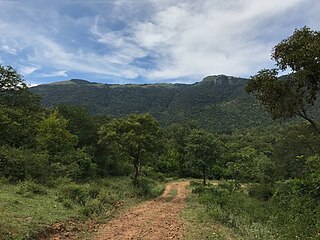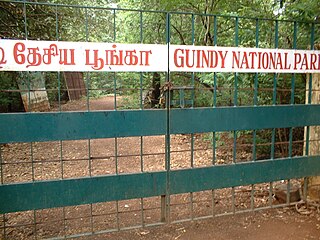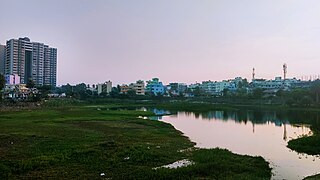
Bannerghatta National Park is a national park in India, located near Bangalore, Karnataka. It was founded in 1970 and declared as a national park in 1974. In 2002, a small portion of the park became a zoological garden, the Bannerghatta Biological Park.

Lalbagh Botanical Garden or simply Lalbagh, is an botanical garden in Bangalore, India, with an over 200-year history. First planned and laid out during the dalavaiship of Hyder Ali and later managed under numerous British Superintendents before Indian Independence. It was responsible for the introduction and propagation of numerous ornamental plants as well as those of economic value. It also served a social function as a park and recreational space, with a central glass house dating from 1890 which was used for flower shows. In modern times it hosts two flower shows coinciding with the week of Republic Day and Independence Day. As an urban green space along with Cubbon Park, it is also home to numerous wild species of birds and other wildlife. The garden also has a lake adjoining a large rock on which a watchtower had been constructed during the reign of Kempegowda II.

The Biligirirangana Hills or Biligirirangan Hills is a hill range situated in south-western Karnataka, at its border with Tamil Nadu in South India. The area is called Biligiri Ranganatha Swamy Temple Wildlife Sanctuary or simply BRT Wildlife Sanctuary. It is a protected reserve under the Wildlife Protection Act of 1972. Being close to the Eastern Ghats as well as the Western Ghats, the sanctuary has floral and faunal associations with both regions. The site was declared a tiger reserve in January 2011 by the Karnataka government, a few months after approval from India's National Tiger Conservation Authority.

Guindy National Park is a 2.70 km2 (1.04 sq mi) protected area of Tamil Nadu, located in Chennai, India, is the 8th-smallest National Park of India and one of the very few national parks situated inside a city. The park is an extension of the grounds surrounding Raj Bhavan, formerly known as the 'Guindy Lodge', the official residence of the governor of Tamil Nadu, India. It extends deep inside the governor's estate, enclosing beautiful forests, scrub lands, lakes and streams.

The Deccan thorn scrub forests are a xeric shrubland ecoregion of south India and northern Sri Lanka. Historically this area was covered by tropical dry deciduous forest, but this only remains in isolated fragments. The vegetation now consists of mainly of southern tropical thorn scrub type forests. These consist of open woodland with thorny trees with short trunks and low, branching crowns; spiny and xerophytic shrubs; and dry grassland. This is the habitat of the great Indian bustard and blackbuck, though these and other animals are declining in numbers; this area was at one time home to large numbers of elephants and tigers. Almost 350 species of bird have been recorded here. The remaining natural habitat is threatened by overgrazing and invasive weeds, but there are a number of small protected areas which provide a haven for the wildlife. Trees in these forests have adapted to not require much water.
Puttenahalli WS Lake also spelled as Puttanahalli Lake is a 10-hectare water body near Yelahanka, 14 km north of Bangalore.

The state of Karnataka in South India has a rich diversity of flora and fauna. It has a recorded forest area of 38720 km2 which constitutes 22.3467719% of the total geographical area of the state. These forests support 25% of the elephant population and 20% of the tiger population of India. Many regions of Karnataka are still unexplored and new species of flora and fauna are still found. The Western Ghats mountains in the western region of Karnataka are a biodiversity hotspot. Two sub-clusters of the Western Ghats, Talacauvery and Kudremukh in Karnataka, are in a tentative list of sites that could be designated as World Heritage Sites by UNESCO. The Bandipur and Nagarahole national parks which fall outside these subclusters were included in the Nilgiri biosphere reserve in 1986, a UNESCO designation. Biligiriranga Hills in Karnataka is a place where Eastern Ghats meets Western Ghats. The state bird and state animal of Karnataka are Indian roller and the Indian elephant respectively. The state tree and state flower are sandalwood and lotus respectively. Karnataka is home to 524 tigers.
BTM Layout or Kuvempunagara is a locality in Bengaluru, Karnataka, India.

Hebbal Lake is located in the north of Bangalore at the mouth of National Highway 7, along the junction of Bellary Road and the Outer Ring Road (ORR). It was one of the three lakes created in 1537 by Kempe Gowda. Like most lakes or "tanks" in the Bangalore region it was formed by the damming natural valley systems by the construction of bunds. The spread of the lake in a study in 2000 was found to be 75 ha with plans for extending it to make up 143 ha.

Madiwala lake is one of the biggest lakes in Bangalore, India spread over an area of 114.3 hectare. Legend has it that the lake was built by the Cholas in a day. The water in the lake was fit for drinking till the early 1990s. Since then it has become unfit for drinking due to industrial waste and sewage entering the waterbody. It has gradually become polluted.
Lakes and tanks in the metropolitan area of Greater Bangalore and the district of Bangalore Urban refer to reservoirs of varying sizes constructed over a number of centuries by various empires and dynasties for rainwater harvesting. Historically, these reservoirs were primarily either irrigation tanks or for the water supply, with secondary uses such as bathing and washing. As Bangalore grew from a small settlement into a city, both of the primary historical uses of the tanks changed. Agricultural land witnessed urbanization and alternate sources of water were provisioned, such as through borewells, piped reservoir water and later river water from further away.

Kaggalipura is a village along Kanakapura Road on the outskirts of Bangalore, in the southern state of Karnataka, India. Kaggalipura is located on the Bangalore-Coimbatore National Highway NH 209, around 20km south of Bangalore. The village is named after the Kaggali tree which grows in abundance locally. The village was established after clearing several Kaggali trees from the area, hence the name Kaggalipura.
Yelahanka Lake is a water body near Yelahanka, a suburb of Bangalore.

Zafar Rashid Futehally was an Indian naturalist and conservationist best known for his work as the secretary of the Bombay Natural History Society and for the Newsletter for Birdwatchers a periodical that helped birdwatchers around India to communicate their observations. Awarded Padma Shri by the Government of India in the year 1971, Zafar Futehally was also honoured with Dutch order of merit the Order of the Golden Ark in 1981 and Karnataka Rajyotsava award by the Government of Karnataka in 1983.

Puttenahalli lake is a small, restored freshwater lake located in JP Nagar 7th Phase, South Bangalore. The area of the lake is about 13 acres. The primary water sources are rain and surface water diverted to the lake through channels. The lake is currently maintained by Puttenahalli Neighbourhood Lake Improvement Trust (PNLIT) . The lake was on the brink of extinction, but due to the efforts of PNLIT, is now a haven for bird-watchers and on its way to being completely restored.

Bannerghatta Biological Park was initially a small zoo and picnic corner within Bannerghatta National Park (BNP) which was started in 1974. The bifurcation of the Biological Park and the National Park took place in 2002. The Bannerghatta Biological Park covers a total area of 731.88 hectares and includes a zoo, safari park, butterfly park and rescue centre. The Zoo Authority of Karnataka, the University of Agricultural Sciences, Bangalore, and the Ashoka Trust for Research in Ecology and Environment (ATREE), Bangalore, are collaborating agencies. For the convenience of the general public, the Governing Council of Zoo Authority of Karnataka had decided to rename Bannerghatta Biological Park as 'Bengaluru Bannerghatta Biological Park' (BBBP).
The Lake Development Authority (LDA) in Bangalore, Karnataka, and its successor the Karnataka Lake Conservation and Development Authority (KCLDA) were formed in 2002 and 2015 respectively. Karnataka Tank Conservation and Development Authority (KTCDA) under the Minor Irrigation Department became the superseding agency.

Sethuram Gopalrao Neginhal was an Indian forest official and conservationist who is credited with generating the green cover around the Indian city of Bangalore leading to the city being referred to as The Garden City. He was associated with the launch of Project Tiger and led wildlife conservation actions including development of the Bandipur Tiger Reserve. In addition to being an expert on wildlife and plant life he was an awarded wildlife photographer.














